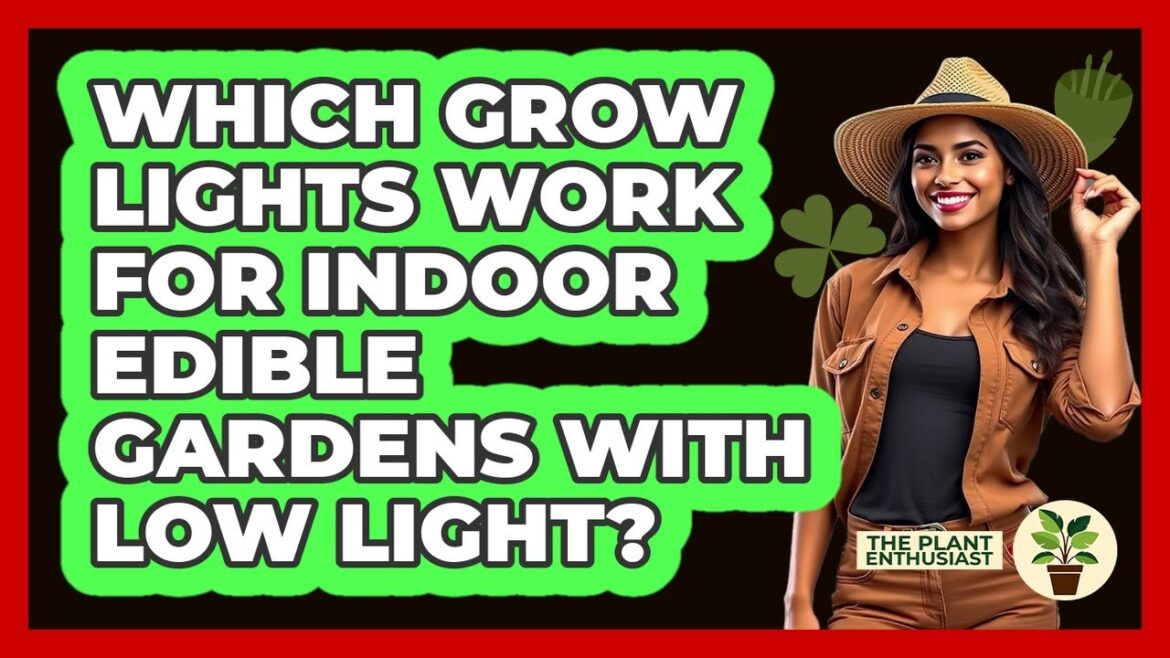Which Grow Lights Work For Indoor Edible Gardens With Low Light? Are you interested in growing fresh, healthy edible plants indoors but struggle with limited natural sunlight? In this video, we’ll explore which grow lights are most effective for indoor edible gardens in low light conditions. You’ll learn about different lighting options, including LED, fluorescent, and high-pressure sodium lights, and discover how to choose the best one for your space and plants. We’ll explain the benefits of LED grow lights, such as energy efficiency and low heat emission, making them ideal for small or low-light areas. You’ll also find out how to position your lights correctly and how long to keep them on each day to maximize plant growth. Whether you’re growing herbs, leafy greens, or small vegetables, understanding the right lighting setup can make all the difference in maintaining a thriving indoor garden. We’ll share tips on adjusting light spectrum and distance to suit different plant needs, helping you achieve lush, healthy plants even in challenging lighting conditions. If you want to turn a dull corner of your home into a productive garden, this video is perfect for you. Subscribe for more helpful tips on indoor gardening and plant care!
⬇️ Subscribe to our channel for more valuable insights.
🔗Subscribe: https://www.youtube.com/@The-Plant-Enthusiast/?sub_confirmation=1
#IndoorGardening #GrowLights #LowLightPlants #EdibleGarden #PlantCare #LEDGrowLights #HerbGarden #VegetableGarden #HomeGardening #PlantTips #IndoorPlants #PlantLighting #GardeningHacks #UrbanFarming #PlantEnthusiast
About Us: Welcome to The Plant Enthusiast, your go-to destination for everything related to the wonderful world of plants! Whether you’re a seasoned gardener or just starting your green journey, our channel is dedicated to nurturing your passion for plant care, cultivation, and creativity.
[Music] Which grow lights work for indoor edible gardens with low light? Imagine turning a dim corner of your home into a lush vegetable patch. It’s possible even in low light if you pick the right grow lights. When growing edible plants indoors, especially where natural sunlight is limited, choosing the correct lighting is key. Different plants have different needs, so understanding what each type of grow light offers can help you succeed. Lead grow lights are often the best choice for low light spaces. They are energy efficient and produce very little heat, so they can be placed close to your plants without burning them. Fullsp spectrum lead lights mimic natural sunlight and support all growth stages from seedlings to harvest. You can find these lights in sizes from small clip-on models to larger panels costing anywhere from $20 to $200. For low light areas, a 20 to 50 W lead panel placed 6 to 12 in above your plants works well. Fluorescent grow lights are another option. They are less efficient than lids, but still useful, especially for seedlings and leafy greens. Compact fluorescent bulbs come in tubes or spiral shapes, and a standard 4ft foot tube can cost about $10. These should be placed about 6 to 8 in from your plants. They emit cooler light, which is gentle on plants, but they don’t penetrate as deeply as leads. High-pressure sodium grow lights are more intense and usually used for larger gardens or fruing plants. They produce a lot of heat and requiring proper ventilation. For small indoor gardens, especially in low light, they are less suitable unless you have a well ventilated space and want to grow larger plants like tomatoes. These lights can cost around $100 to $200 and need a ballast to operate safely. For low light conditions, lead grow lights are the most practical. They allow you to keep your edible plants healthy and productive without overheating or wasting energy. Place the lights close to your plants about 6 to 12 in away and keep them on 410 to 18 hours a day depending on the plant. Use full spectrum lights for most vegetables and herbs, but switch to warmer lights around 2500 to 3,000 Kelvin for fruing plants. Cooler lights around 6,000 Kelvin are better for leafy greens. You can also add side lighting or adjustable fixtures to reach lower parts of the plants. This helps ensure even growth and prevents legggininess. When setting up your indoor edible garden in a low light space, focus on these lighting options and adjust the distance and duration to match your plant’s needs. With the right grow lights, you can enjoy fresh herbs, greens, and even small vegetables right in your home, no matter how little sunlight comes through your windows. [Music]


Comments are closed.